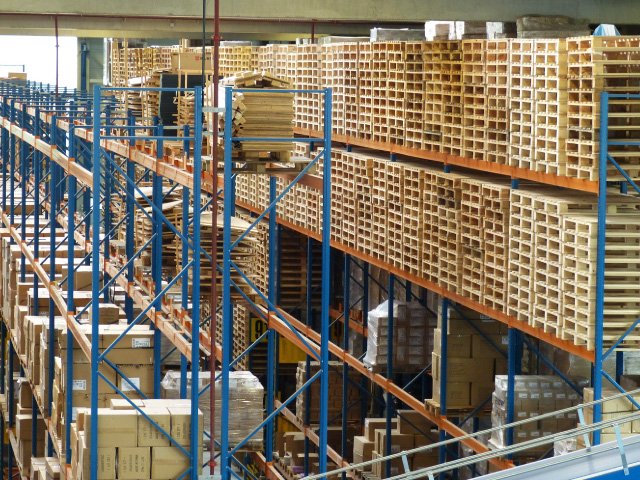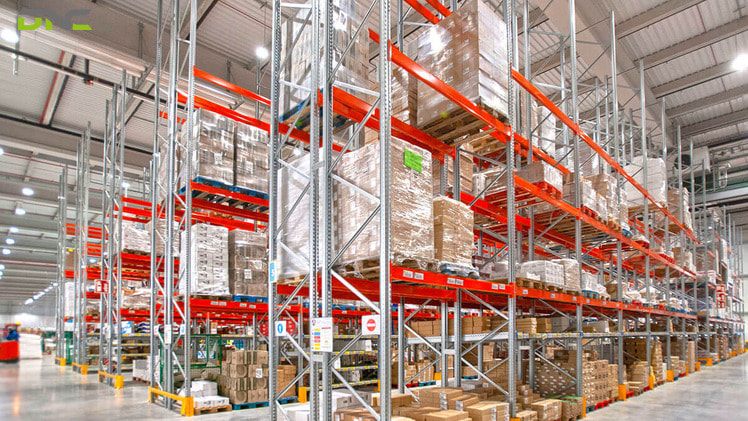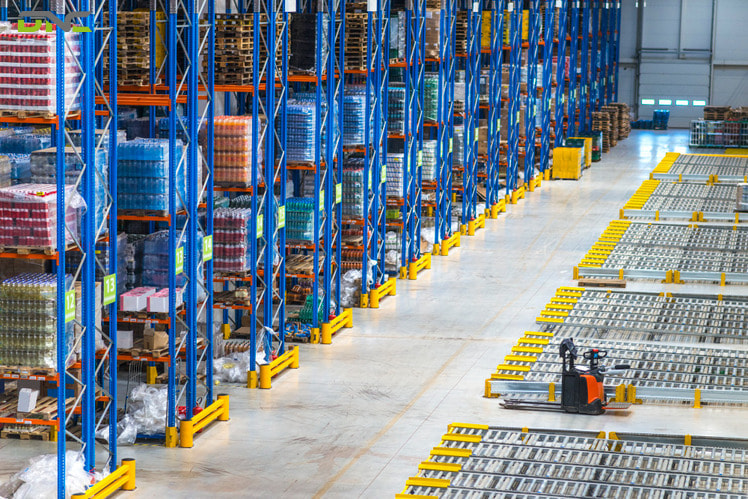Smart Warehouse Racking System solution for modern warehouse
Overview of Warehouse Racking
A smart warehouse racking system plays a critical role in modern logistics and manufacturing, helping businesses maximize storage space, improve operational efficiency, and ensure safety. DNC Automation provides comprehensive Warehouse Racking solutions in Malaysia, designed to optimize warehouse layout, workflow, and overall performance.
What Warehouse Racking Solutions Does DNC Offer?
In modern warehouse management, each type of goods and operating model will be suitable for a different type of shelf system. Below are the 6 most popular types of Warehouse Racking System today:
Selective Racking
This is the most popular type of warehouse shelf, allowing direct access to each pallet. Selective Racking is suitable for warehouses with many different types of products and high import and export frequency.
Pros
- Direct access to each pallet, easy inventory management.
- Suitable for a wide variety of products.
- Easy to install and adjust.
- Lowest investment cost among racking systems.
Cons
- Floor space utilization is low (around 35–40%).
- Requires multiple aisles for forklifts.
- Not ideal for storing large quantities of identical goods.
Drive-In/Drive-Through Racking
This racking system allows forklifts to move into the rack to pick up or put away pallets. Drive-In (one entrance/exit) and Drive-Through (multiple entrances/exits) help store large quantities of goods, uniformly, saving up to 60% space. Suitable for the frozen food, chemical or raw material industries.
Pros
- Optimizes warehouse capacity for bulk storage.
- Minimizes floor space required for large volumes of goods.
- Supports efficient inventory rotation, especially for perishable products.
Cons
- Less suitable for warehouses handling diverse SKUs.
- Restricted to either LIFO or FIFO inventory management methods.
Push-Back Racking
Push-Back racking allows multiple pallets to be placed on an inclined rail. When a new pallet is inserted, the old pallet will be pushed back. This system optimizes space while still ensuring the speed of import and export, often applied to warehouses with medium to large volumes of goods.
Pros
- Maximizes warehouse capacity with high-density storage.
- Streamlines loading and unloading operations.
- Well-suited for bulk goods that don’t require strict rotation.
Cons
- Less effective for inventory that needs frequent rotation.
- Higher investment cost due to specialized design and inclined rails.
Pallet Flow Racking
Flow racks use gravity rollers to move goods from the loading side to the picking side, following a FIFO system. This ensures automatic product rotation without electricity, making them ideal for industries that require strict inventory control such as food, beverage, and pharmaceuticals. They are especially effective in high-volume, fast-moving warehouses.
Pros
- No electricity required
- Automatic inventory rotation (FIFO)
- Improves picking and replenishment efficiency
Cons
- Higher cost due to rollers and brakes
- Best suited for uniform products
- More complex to install
Mobile Racking
Mobile Racking is a racking system that can move on rails, allowing aisles to be opened when needed. This is a space-optimizing solution, increasing warehouse capacity by up to 80% compared to static racking. Suitable for warehouses with high space costs or needing to store large volumes.
Pros
- Maximizes storage capacity (up to 80% more than static racking)
- Reduces the number of aisles required
- Ideal for warehouses with limited space or high real estate costs
- Provides direct access to all pallets when aisles are opened
Cons
- Higher investment cost due to rails and motorized systems
- Slower access compared to static racking
- Not ideal for high-frequency picking operations
Cantilever Racking
Cantilever Racking is designed to store long goods such as steel pipes, wood, and construction materials. Thanks to the design without columns between floors, this type of racking makes it easy to load and unload goods by forklift or manually.
Pros
- Ideal for storing long, bulky, or irregular items (pipes, timber, construction materials).
- Open design without front columns allows easy loading/unloading.
- Can be accessed by forklift or manual handling.
- Flexible in adjusting arm lengths and rack heights.
Cons
- Not suitable for standard palletized goods.
- Lower storage density compared to pallet racking systems.

warehouse racking system
What Are the Benefits of Choosing DNC’s Warehouse Racking Solutions?
Investing in a warehouse racking system not only helps optimize storage but also brings long-term value to the business. Here are 5 outstanding advantages of Warehouse Racking System:
- Optimizing storage space: Warehouse Racking System maximizes the height of the warehouse, increasing capacity up to 2-3 times compared to floor storage.
- Improve the efficiency of goods management: Modern shelves allow for scientific classification of goods, easy control according to the FIFO/FEFO principle or by area.
- Save operating costs: Businesses reduce warehouse rental costs, limit wasted space and optimize human resources thanks to reasonable arrangement.
- Speed up the import and export process: Combined with forklifts, automatic systems (AS/RS, AGV), picking and importing goods takes place quickly, accurately, and limits errors.
Ensure the safety of goods and employees: Warehouse shelves are designed to meet safety standards, have good load capacity, and avoid damage to goods or causing danger during operation.
Choosing DNC’s solutions ensures that your warehouse operates efficiently, safely, and cost-effectively
What are the factors to consider before choosing a warehouse racking system?
Before investing in a Warehouse Racking System, businesses need to carefully analyze to choose the most suitable solution. Here are 5 things you should know:
- Product characteristics: Size, weight, packaging type (pallets, packages, cartons) directly affect the type of rack to choose.
- Warehouse area & height: For warehouses with high ceilings, multi-level racking or AS/RS will be effective; while small and narrow warehouses can prioritize mobile racking or selective racking.
- Rate of goods rotation: If goods need to be imported and exported continuously, you should choose selective or pallet flow racking; but if stored for a long time, drive-in/drive-through is more suitable.
- Investment budget: Warehouse racking costs have a big difference between traditional and automated solutions. Businesses need to balance between financial capacity and long-term development orientation.
- Ability to integrate automation: If a business plans to build a smart warehouse, it should choose a racking type that is compatible with AS/RS, AGV or WMS software.

5 factors to consider before choosing a warehouse racking system
Warehouse Rack FAQs
- How much does it cost to rack a warehouse?
The cost of warehouse racking depends on several factors: warehouse size, ceiling height, the type of products you store, and the racking system you choose. Basic selective racking is the most affordable, starting at about 50 USD per pallet position, while more advanced systems like pallet flow or mobile racking can reach 2.000 USD –2.500 USD per pallet position.
2. How much weight can a pallet rack hold?
Weight capacity varies widely based on the rack design, materials, and manufacturer. Standard pallet racks can hold anywhere from 1,500 lbs to over 6,000 lbs per level. Heavy-duty systems can support even more, designed for industrial or bulk storage.
Always calculate the maximum load per pallet and per bay, and choose a racking system with a safety margin above your heaviest pallet weight. Exceeding weight limits risks rack failure and workplace accidents.
3. What is double deep racking?
Double deep racking is a high-density storage system where pallets are stored two deep on both sides of an aisle. This doubles storage capacity compared to standard selective racks and reduces aisle space, making it ideal for operations where space is limited.
However, it requires specialized forklifts with extended reach and works best for LIFO (Last In, First Out) inventory systems. Double deep racking is commonly used in warehouses with medium to low SKU variety but large quantities of each SKU.
4. Do pallet racks need to be bolted to the floor?
Yes, pallet racks must always be anchored to the floor. Bolting racks ensures structural stability, especially in facilities using forklifts and other mechanical handling equipment. Anchoring prevents tipping, reduces the risk of rack collapse, and often increases weight capacity.
5. How much space do you need between pallet racks?
There should be at least 3–4 inches of clearance between racks (even in back-to-back setups) to prevent accidental contact or damage to frames. This spacing also allows airflow and fire suppression systems to function properly. For aisles, spacing depends on equipment:
- Narrow aisles: 6–8 feet (for specialized narrow-aisle trucks).
- Standard aisles: 12–13 feet (for standard forklifts).
- Wide aisles: 14+ feet (for high-capacity or larger forklifts).
6. Do warehouse racks need a permit?
In most regions, yes, installing warehouse racks requires permits and inspections to ensure compliance with building codes, fire safety regulations, and occupational safety standards. Permits are especially important for racks above a certain height (e.g., 8 feet or more).

Warehouse Rack FAQs
Why Should You Choose DNC Automation?
Selecting the right partner is crucial for a successful warehouse racking project. DNC Automation offers extensive experience and end-to-end services to guarantee optimal performance:
-
Proven experience: Successfully implemented numerous projects across Malaysia.
-
Comprehensive solutions: From consulting and design to installation, integration, and maintenance.
-
Seamless integration: Combining racking systems with robots and ASRS for smart warehouses.
-
Optimized ROI: Cost-effective solutions with stable, long-term operations.
Contact DNC Automation today to get expert consultation and a tailored Warehouse Racking solution that fits your business needs. Our team is here to help you maximize storage, improve efficiency, and ensure long-term reliability.



